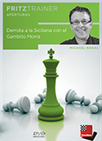Una sensación maravillosa
Michael Rahal dejó el ajedrez competitivo a favor de ser entrenador. En una entrevista que le realizó Daniel Muñoz en 2017, Michael Rahal comentó:
"Mi carencia principal es mi sistema nervioso: muchas son las partidas que he dejado de ganar o de hacer tablas por los nervios en momentos clave, o por la pérdida de la concentración. Pero no me puedo quejar: he llegado al título de maestro internacional y en el campo de la enseñanza me encuentro muy a gusto ayudando a otros a hacer lo mismo, quizás intentando evitar los fallos que he tenido yo".
Michael vive en Barcelona pero nació y se crió en Inglaterra. Eso le da la ventaja que ahora tiene tres "idiomas maternas" que habla con soltura: el inglés, el español y el catalán.

Michael Rahal con sus alumnos
La partida más memorable de su carrera para Michael ha sido la primera victoria que conquistó frente a un gran maestro, Carlos García Palermo, en 1993.
La partida comentada por Michael Rahal (en inglés)
Rahal, Michael vs. Garcia Palermo, Carlos
El Vendrell, 1993 (Tarragona, España)
1.e4 c6 2.d4 d5 3.f3
Carlos was — and still is — a very strong player with a solid style, so I sort of expected that the Caro-Kann might appear on the board. We used to prepare the games with the Informators and tournament Bulletins: Chessbase was still in its early days and hardly anyone had a laptop. At the time, I was dabbling with several different lines against the Caro-Kann and the Fantasy Variation was one of my favourites. I still bring it out from time to time, although more as a surprise weapon.
3...dxe4 4.fxe4 e5

Derrota a la Siciliana con el Gambito Morra
El blanco sacrifica un peón en la segunda jugada a cambio de un desarrollo rápido de piezas y buenas opciones de ataque, y el negro puede caer muy fácilmente en alguna de las muchas celadas sibilinas en plena apertura.
Más...
5.Nf3 Be6 6.c3 A solid move, bolstering my centre
6...Nd6 7.Bd3 Ngf6 8.Qe2 Bd6 9.Nbd2 0-0 10.0-0
Both sides have developed their pieces to decent squares and I thought that the position was about equal. I still have to find a good square for my c1-bishop, but on the plus side I have an extra central pawn and the f-file for my heavy pieces.
10...Qb6? Pressuring the b2 and d4-pawns. At first glance this move seems strong but the computer prefers the slightly more passive ...Qc7, followed maybe by ...Rfe8.
11.Kh1 Rae8 12.b3 It seemed to me that developing the bishop on b2 had to be the best decision. I also overprotect the c4-square just in case.
12...Qd8 13.Bb2 Nh5!
A good move. The knight is heading to a very strong square. I can play g3 but that would weaken the light squares near my king. I decided that losing the d3 bishop wasn't the end of the world as long as he had to exchange the strong knight which will soon land on f4.
14.Nc4 Bxc4! Garcia Palermo correctly swaps off my strong light-squared bishop and goes for the attack.
15.Bxc4 b5 16.Bd3 f5!?
A double-edged move (which the computer approves even today). I was expecting ...Nf4 so this thrust caught me by surprise. I was sensing that if the game opened up my queen on e2 would be in danger in front of his rook, so I decided to move it away. Stockfish is giving 0.00 right here, although I am sure that during the game I thought I was worse (especially while facing a grandmaster!)
17.Qc2 f4?
Now I understand that this is clearly a mistake, although I can't remember if I realised it during the game. Black had several decent moves, such as ...Nf4 or ...Nhf6, with a complex game ahead. The problem with the text move is that the knight on h5 is stranded on the edge and, more importantly, I can now hit my opponent with 18.c4!, opening up the game for my two bishops without facing the extra pressure on my e4-pawn. I am sure that my opponent thought he had time to play aggressively with ...g5-g4 ...Qh4 (even ...Ng3 at some point).
18.c4! exd4 19.cxb5 c5 20.b4!
Again, a no-brainer that Stockfish also approves. White has to break open the c5-d4 structure to take advantage of the bishop pair. I was probably getting over-excited here, which is one of the problems I have faced all along my career as a chess player.
20...cxb4 21.Bxd4 Ne5
A critical position. White has many moves to consider, such as Bxa7, Rad1, Rac1, among others. However, for some reason I overvalued my light-squared bishop and decided to exchange the powerful knight on e5. I can't remember the exact reasons but I was probably concerned with ...Ng4, with too many pieces near my king.
22.Bxe5?! Rxe5? Over-optimistic, although I was slightly worried during the game of course. My opponent prefers to give up his rook for my knight in order to retain his dark-squared bishop. I am sure that he had calculated some lines with a queen on h4 and maybe the bishop heading to the g1-a7 diagonal: there are many mating patterns with that piece disposition.
23.Nxe5 Bxe5 24.Bc4+ Kh8 25.Rad1 Qf6?
26.g4! A bolt out of the blue! The knight is trapped: a fitting finish for the game. Palermo couldn't have seen this move in advance: no one is really thinking of touching his kingside pawns in this situation!
26...Ng3+ 27.hxg3 f3 28.Qh2!
Protecting g3 and stopping ...Qh6. Black resigned. As you can all imagine I was very happy with the outcome: not only had I defeated my first grandmaster in the last round of the tournament, but it was also quite a decent game.
1-0
La partida comentada (en inglés)

Derrota a la Siciliana con el Gambito Morra
El blanco sacrifica un peón en la segunda jugada a cambio de un desarrollo rápido de piezas y buenas opciones de ataque, y el negro puede caer muy fácilmente en alguna de las muchas celadas sibilinas en plena apertura.
Más...

























